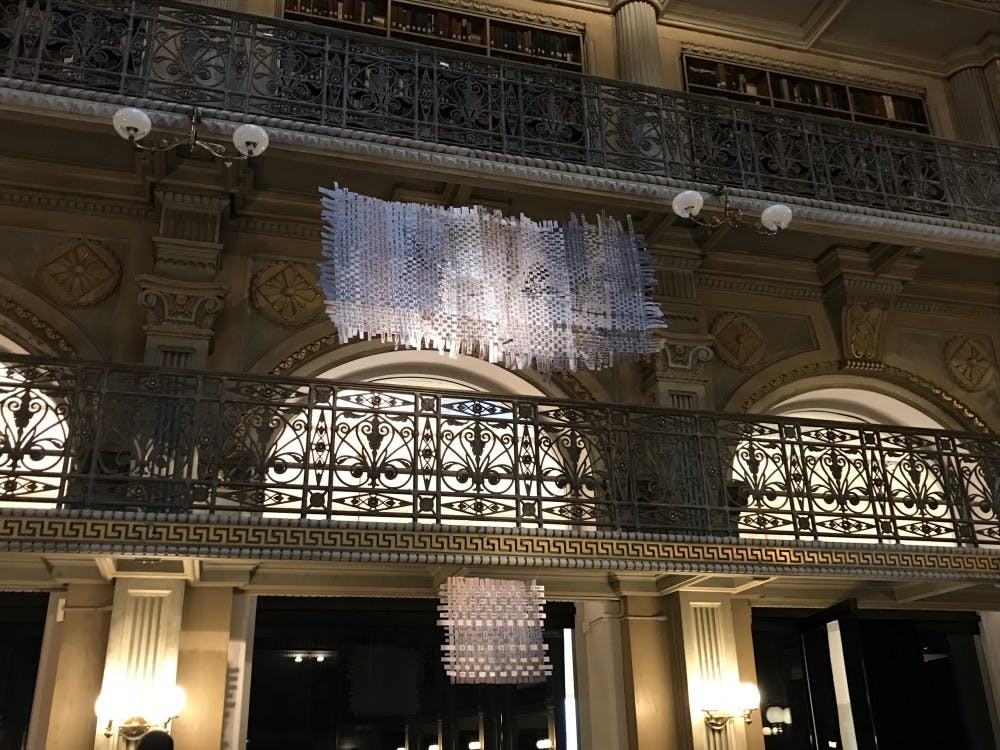On Friday, March 30, Hopkins junior Julia Zimmerman debuted a new contemporary art exhibit titled Present at Peabody. Zimmerman curated the site-specific exhibit with funding from an Andrew W. Mellon Arts Innovation Grant.
The exhibit, which will be on display at the George Peabody Library until Sept. 9, features the work of student-artists Yoonjung Cho, Margaret Curnow, Gillian Waldo, Courtney Cooper, Mazzy Bell and Camille Cropley.
The opening reception for the exhibit drew a crowd of students from Hopkins and Peabody, as well as artists, adult community members and young children.
As attendees passed through the grand historic space, they had the opportunity to view a range of pieces: from oil paintings to a large freestanding sculpture to a hanging basket made from images of text found at the library.
Before creating this exhibit at Peabody, Zimmerman had previous experience in curation. In high school she worked as an intern for a company that specialized in site-specific exhibitions at historic sites.
After her freshman year at Hopkins, she contributed to a similar show at the Katonah Museum of Art in New York. She had been formulating plans for Present at Peabody before she applied for the Mellon Grant over a year ago.
“I had been thinking about doing a site-specific exhibition in a historic Baltimore building for a while,” she wrote in an email to The News-Letter. “My application for the Arts Innovation Grant was really similar to how the show ended up turning out. I had been thinking about the logistics of an exhibition of that scale for a while before I even started writing the application so I was pretty thorough with every detail that went into it.”
Zimmerman also explained that her proposal for the exhibit reflected her interest in the importance of historical sites.
“The first line of the grant proposal was, ‘By reminding us of our past, historical sites help us understand the present and when engaged through artistic and personal interpretation can provide insights about the continued relevance of an institution,’ and I stand by that as the end goal of the exhibition,” she wrote.
After receiving the grant in the spring of 2017, Zimmerman spent the summer in Baltimore researching the history of the George Peabody Library and familiarizing herself with its collections. Armed with this background information, she released an open call to potential artists, looking specifically for student-artists in the Baltimore area.
Her call received submissions from a range of artists, from first-years to graduate students. She then collaborated with the curator of the Peabody Library, Paul Espinosa, to select the artists whose work would best fit into the larger themes of the show as well as the history and architecture of the library. Zimmerman oversaw the work of the artists throughout their months long creative processes.
After installing the works of art and presenting them to the public, Zimmerman elaborated on the way in which the pieces relate to the specific space and atmosphere of the site.
“I really want people to leave with a different view of the library space after seeing the new ways the works interact,” she wrote. “We have pieces reflecting the skylight, a detail people tend to miss, floating between floors, and highlighting areas generally overlooked in the traditional decoration of the space.”
She also emphasized the significance of the library as a site of historical space in addition to one of beauty.
“The works in the show really focus on the Peabody Library as an active historical space and I hope that people leave the show internalizing that idea. It is one of the most gorgeous buildings in Baltimore and frequently listed as one of the most beautiful libraries in the country, but there is so much more to it than just its architectural majesty,” she wrote.
Zimmerman also stressed the important contrast between historical and contemporary beauty.
“I think this juxtaposition of past and present in this exhibition will really encourage people to reconsider the space when they encounter it and help foster discussion around the functioning of the library space and its larger history,” she wrote.
In addition to the current visual art exhibit, Zimmerman expressed interest in hosting artist talks and special tours in coming weeks to continue a discussion of these central themes.





